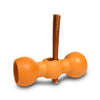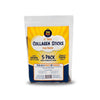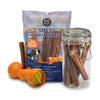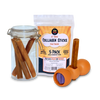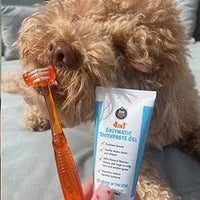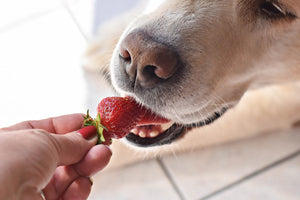“What does my dog have to be stressed or anxious about? He is spoiled and lives the best life!” Believe it or not, no matter how much you pamper your pooch, dogs can feel stress just like we humans do, and for pet parents with anxious dogs, a solution may be closer than you think.
Anxiety is a form of stress that affects a large percentage of dogs. In fact, a large-scale recent study showed that more than 72% of dogs exhibit at least one anxiety-related behavioral issue. 1 And while our dogs may not have to worry about work, bills or deadlines, they are incredibly sensitive to their immediate environment, and this can manifest into behavioral issues. A loud thunderstorm, a new couch, a surprise houseguest or even just you walking out the door can trigger anxiety in your dog. The resulting behaviors may turn destructive and account for a major reason for dogs being rehomed. 2
The good news? Dogs have built-in ways to cope, and one of the most powerful ones is also surprisingly one of the simplest: chewing.
But before we dive into how chewing helps, let’s look at why anxiety happens in the first place.

What Causes Stress and Anxiety in Dogs?
While dogs may be able to understand a handful of words (or more, if you have a real smarty pants on your hands), they are nonverbal beings that rely on consistency and predictable patterns to be in their best mental state. For them, little things can cause big stress. Moving homes, a change in routine, new smells, unexpected sounds (like thunder or the clank of a dropped pan) or being left alone are all common triggers that can throw them off completely. Even rearranged furniture can cause them stress and anxiety!
In some dogs, this may appear as them pacing, whining or tearing things apart when left alone. For others, this can show up in their body. You might notice signs like panting, yawning, shaking, increased heart rate, drooling and trembling, to name a few.
And here’s the kicker: a study from 2024 showed that when dogs are chronically stressed, there is an increase in anxiety that makes it even harder for them to respond in a normal manner to environmental changes. 3 Their cortisol levels (the main stress hormone) spike, and while cortisol is a natural response, sustained elevated levels can take a toll on their mental and physical health.
Since dogs can’t talk about their feelings or take themselves out on a walk to decompress, they turn to other physical ways to self-soothe. And one of the most instinctive ways a dog will do this? You guessed it: chewing. That’s why many dogs chew furniture, wood trim around doors and windows, their paws or even their favorite toy when anxious.
Why Chewing Works
Chewing isn’t just something dogs like to do. It’s an instinct. Hardwired into their brains as a way to feel better. One study showed that when dogs were left to chew on a long-lasting chew (like a collagen stick), there was a significant reduction in stress and anxiety over any other type of enrichment. 4 That repetitive, soothing activity has a calming effect on their entire nervous system.
It’s kind of like how we humans chew gum and see a quick reduction in our own anxiety with lowered cortisol levels. 5 For dogs, it’s the same: chewing lowers cortisol, calms their brain and gives them something to stimulate their mind that provides a distraction. This offers you, the pet parent, an opportunity to offer your dog a coping strategy that is anything but destructive.

Chewing and the Feel-Good Brain Chemistry
But chewing does more than just lower cortisol, and here’s where it gets really cool: chewing can actually boost dopamine, the feel-good brain chemical that helps regulate mood. Studies in humans (and other animals) have shown that chewing during stress increases dopamine levels and, as a result, reduces anxiety behaviors. 6 And since our dogs share similar brain structures, they likely get the same benefit.
This creates a powerful, positive feedback loop. When a dog chews, they feel better, so they chew again the next time they’re stressed, instead of turning to less helpful behaviors like barking nonstop or tearing up their bed. That’s a win for both of you.
Beyond Stress Relief: Other Benefits of Chewing
At Bow Wow Labs, we are big advocates for safe chewing experiences. That’s because chewing isn’t just great for emotional health, but it’s good for our dogs’ oral and mental health, too. Regular chewing can:
- Reduce plaque and tartar buildup, helping support better dental health
- Prevent boredom by providing them with something mentally stimulating. And in case you didn’t know, boredom is a big source of anxiety, especially in smart and/or high-energy breeds
- Keeps jaw muscles healthy by providing repetitive exercise that helps strengthen these (mostly) infrequently used muscles
- Provide mental stimulation as an important tool that (note above) prevents boredom
A dog that’s chewing on something appropriate is a dog that is engaged, content and doing something good for their brain and overall well-being.

How to Help Your Dog Use Chewing to Cope with Stress and Anxiety
Offering chews at the right time makes a big difference. Here are a few simple tips to help your pup get the most benefit:
- Offer a chew before a stressful event. Heading out? Storm rolling in? Hand your dog a chew before anxiety kicks in. If you leaving the house is a trigger for your dog, remember they are very observant beings that thrive on patterns. Their anxiety may start when they see you putting on your shoes, putting a purse on the counter or any other habit you have as a part of your departure.
- Choose safe, long-lasting chews. Think collagen sticks, bully sticks or other natural chews, and always supervise. We recommend using a safety device like the Bow Wow Buddy® to hold the chew and prevent choking.
- Switch it up! Remember I mentioned boredom? This can happen with treats and chews, too. Rotate different types of chews to keep things fresh and exciting.
- Redirect, don’t punish. If your dog chews something they shouldn’t, gently redirect them to a safe option. Punishment adds stress, which can make inappropriate chewing worse.
- Create a calm space for them to relax. Instrumental music has been shown to reduce stress in dogs. 7 Providing this, along with a comfy and relaxed space, can amplify the calming effect of chewing.
If severe anxiety is something your dog struggles with, it might be a good idea to consult your vet and/or a certified canine behaviorist. Chewing is a powerful tool, but sometimes a more customized, holistic plan is required.
The Bottom Line
Chewing is more than just a fun way to engage our pups; it’s also a natural, effective way dogs cope with stress. From calming their nervous systems to boosting feel-good chemicals in the brain, it’s one of the simplest and most effective ways to support your dog’s mental health.
So the next time your dog’s facing a tough moment—a thunderstorm, a new guest or a few hours alone—offer them something to chew.
Johnna Devereaux is a Clinical Pet Nutritionist, canine wellness expert and Chief Nutrition Officer for Bow Wow Labs.
* This article is for informational purposes only. It is not, nor is it intended to be, a substitute for professional medical or veterinary advice, diagnosis, or treatment and should never be relied upon or perceived as specific medical or veterinary advice.
**The points of view expressed above are those of our clinical nutritionist and are supported by science, her education and experience. We are committed to providing the best, most straightforward, and most helpful information possible to help keep your dog happy, healthy and safe.
References:
1. Salonen M, Sulkama S, Mikkola S, et al. Prevalence, comorbidity, and breed differences in canine anxiety in 13,700 Finnish pet dogs. Sci Rep . 2020;10(1):2962. doi:10.1038/s41598-020-59837-z
2. Bellamy KKL, Storengen LM, Handegård KW, et al. DRD2 is associated with fear in some dog breeds. J Vet Behav. 2018;27:67-73. doi:10.1016/j.jveb.2018.07.008
3. Mârza SM, Munteanu C, Papuc I, Radu L, Diana P, Purdoiu RC. Behavioral, Physiological, and Pathological Approaches of Cortisol in Dogs. Anim Open Access J MDPI. 2024;14(23):3536. doi:10.3390/ani14233536
4. Flint HE, Atkinson M, Lush J, Hunt ABG, King T. Long-Lasting Chews Elicit Positive Emotional States in Dogs during Short Periods of Social Isolation. Anim Open Access J MDPI. 2023;13(4):552. doi:10.3390/ani13040552
5. Scholey A, Haskell C, Robertson B, Kennedy D, Milne A, Wetherell M. Chewing gum alleviates negative mood and reduces cortisol during acute laboratory psychological stress. Physiol Behav. 2009;97(3-4):304-312. doi:10.1016/j.physbeh.2009.02.028
6. Kubo K ya, Iinuma M, Chen H. Mastication as a Stress-Coping Behavior. BioMed Res Int. 2015;2015:876409. doi:10.1155/2015/876409
7. Lindig AM, McGreevy PD, Crean AJ. Musical Dogs: A Review of the Influence of Auditory Enrichment on Canine Health and Behavior. Anim Open Access J MDPI . 2020;10(1):127. doi:10.3390/ani10010127



